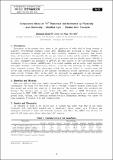Search
Now showing items 1-8 of 8
Comparative Study of Pb2+ Removals and Isotherms by Physically - and Chemically - Modified Agro - Wastes from Tanzania
(Gwangju Institution of Science and Technology, 2016)
Materials and Methods Raw corn and rice husk were washed several times using DIW to remove extraneous dirt and contaminants. The husks were then dried at 110 ºC overnight to remove moisture. Dried husks were then ground ...
Geochemical Distribution of Trace Elements in Groundwater from the North Mara Large-Scale Gold Mining Area of Tanzania
(Ground Water Monitoring and Remediation, 2016-05)
The infl uence of large-scale mining operations on groundwater quality was investigated in this study. Trace element concentrations in groundwater samples from the North Mara mining area of northern Tanzania were analyzed. ...
Assessing Land Use/Cover dynamics of the Ngorongoro world heritage site in Tanzania using a hybrid CA–Markov model
(Authorea, 2020-10)
In this study, land-use/cover pattern of the UNESCO world heritage site, Ngorongoro Conservation Area; is analyzed
using the CA–Markov model with the help of RS and GIS. Hybrid classification techniques ware used to monitor ...
Health Risk Assessment of Trace Elements in Soil for People Living and Working in a Mining Area
(Hindawi, 2021-07-02)
The present study used soils collected from a small-scale gold mine area to determine the health risks due to trace elements to the at-risk population in the study area. The work involved 74 soil samples from four sampling ...
A comprehensive review on the decontamination of lead(II) from water and wastewater by low-cost biosorbents
(Royal Society of Chemistry, 2022-04-12)
The disadvantages of conventional methods in water and wastewater management including the demand
for high energy consumption, the creation of secondary toxic sludge, and operation cost are much too high
for developing ...
Assessment of Groundwater Quality under Changing Climate in Ngorongoro Conservation Area, Tanzania
(American Society of Civil Engineers, 2022-07)
Understanding the hydrochemical composition of water resources in the Ngorongoro Conservation Area (NCA, Dodoma, Tanzania) related to climate variability is essential for sustainable development. Thus, the current study ...
Contribution of Illicit Drug Use to Pharmaceutical Load in the Environment: A Focus on Sub-Saharan Africa
(Hindawi, 2022-07-08)
Illicit drug abuse and addiction are universal issues requiring international cooperation and interdisciplinary and multisectoral
solutions. ese addictive substances are utilized for recreational purposes worldwide, ...
Adsorption and desorption processes of toxic heavy metals, regeneration and reusability of spent adsorbents: Economic and environmental sustainability approach
(Elsevier, 2024-05-19)
A growing number of variables, including rising population, water scarcity, growth in the economy, and the existence of harmful heavy metals in the water supply, are contributing to the increased demand for wastewater ...








